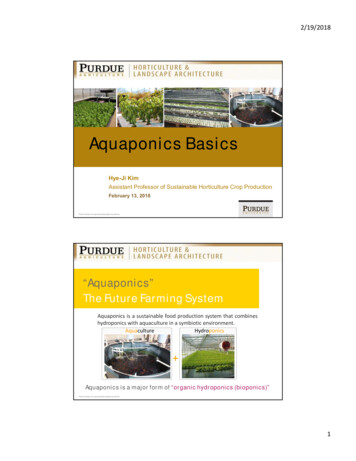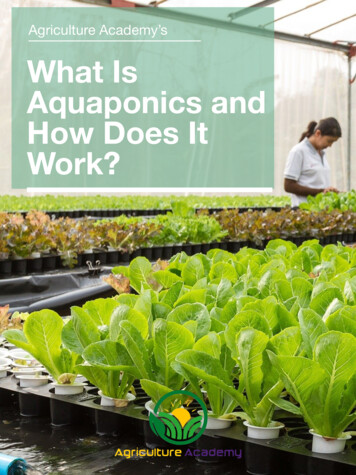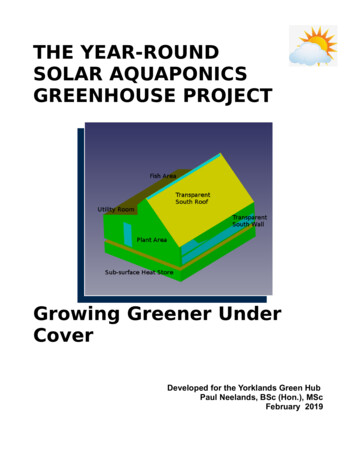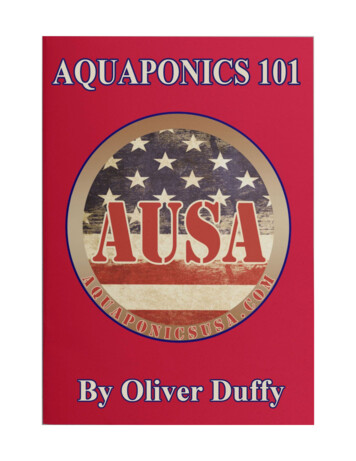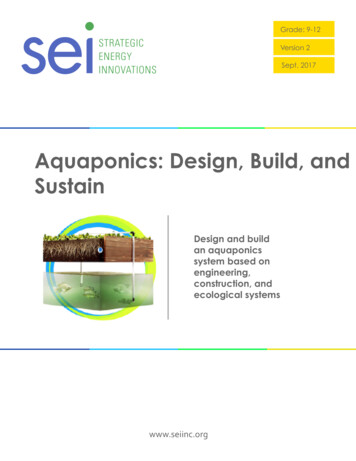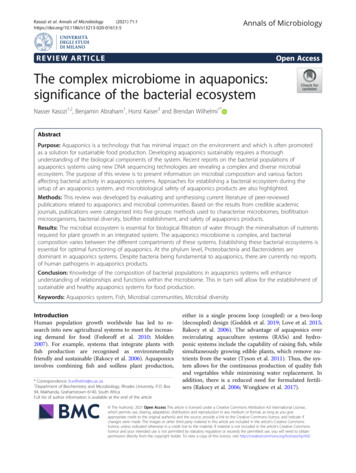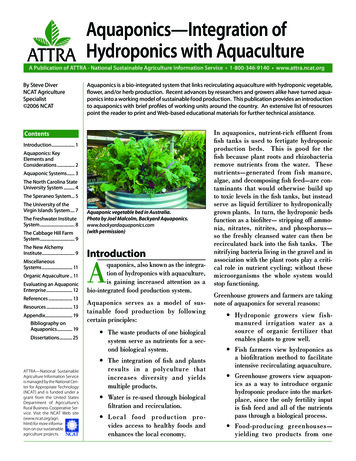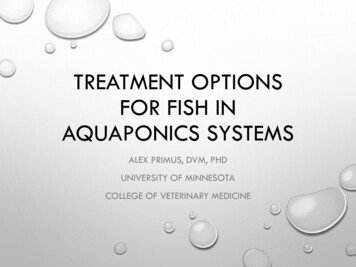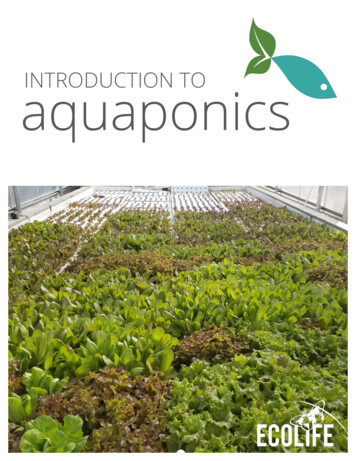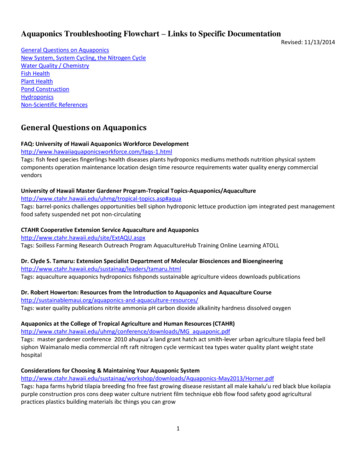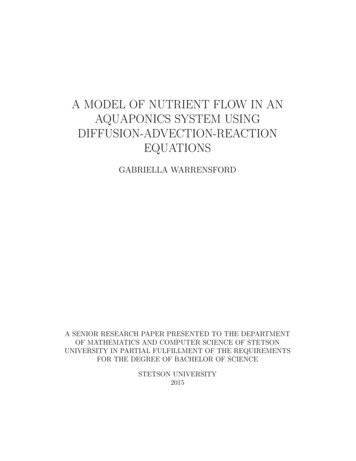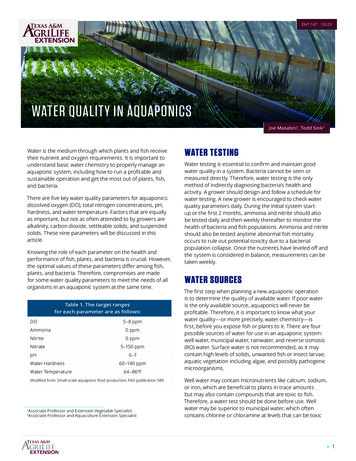
Transcription
EHT-147 10/20WATER QUALITY IN AQUAPONICSJoe Masabni1, Todd Sink 2Water is the medium through which plants and fish receivetheir nutrient and oxygen requirements. It is important tounderstand basic water chemistry to properly manage anaquaponic system, including how to run a profitable andsustainable operation and get the most out of plants, fish,and bacteria.There are five key water quality parameters for aquaponics:dissolved oxygen (DO), total nitrogen concentrations, pH,hardness, and water temperature. Factors that are equallyas important, but not as often attended to by growers arealkalinity, carbon dioxide, settleable solids, and suspendedsolids. These nine parameters will be discussed in thisarticle.Knowing the role of each parameter on the health andperformance of fish, plants, and bacteria is crucial. However,the optimal values of these parameters differ among fish,plants, and bacteria. Therefore, compromises are madefor some water quality parameters to meet the needs of allorganisms in an aquaponic system at the same time.Table 1. The target rangesfor each parameter are as follows:DOAmmonia5–8 ppm0 ppmNitrite0 ppmNitrate5–150 ppmpHWater HardnessWater Temperature6–760–140 ppm64–86ºFModified from: Small-scale aquaponic food production, FAO publication 589.Associate Professor and Extension Vegetable SpecialistAssociate Professor and Aquaculture Extension Specialist12WATER TESTINGWater testing is essential to confirm and maintain goodwater quality in a system. Bacteria cannot be seen ormeasured directly. Therefore, water testing is the onlymethod of indirectly diagnosing bacteria’s health andactivity. A grower should design and follow a schedule forwater testing. A new grower is encouraged to check waterquality parameters daily. During the initial system startup or the first 2 months, ammonia and nitrite should alsobe tested daily and then weekly thereafter to monitor thehealth of bacteria and fish populations. Ammonia and nitriteshould also be tested anytime abnormal fish mortalityoccurs to rule out potential toxicity due to a bacterialpopulation collapse. Once the nutrients have leveled off andthe system is considered in balance, measurements can betaken weekly.WATER SOURCESThe first step when planning a new aquaponic operationis to determine the quality of available water. If poor wateris the only available source, aquaponics will never beprofitable. Therefore, it is important to know what yourwater quality—or more precisely, water chemistry—isfirst, before you expose fish or plants to it. There are fourpossible sources of water for use in an aquaponic system:well water, municipal water, rainwater, and reverse osmosis(RO) water. Surface water is not recommended, as it maycontain high levels of solids, unwanted fish or insect larvae,aquatic vegetation including algae, and possibly pathogenicmicroorganisms.Well water may contain micronutrients like calcium, sodium,or iron, which are beneficial to plants in trace amountsbut may also contain compounds that are toxic to fish.Therefore, a water test should be done before use. Wellwater may be superior to municipal water, which oftencontains chlorine or chloramine at levels that can be toxic 1
to plants or fish. Growers who plan on using municipalwater must treat the water to remove excess chlorine orchloramine before adding fish or plants.Removal of excess chlorine can be done using an ROsystem or by aerating for a couple of days to allow for thechlorine gas to escape. Chlorine test kits are availableat stores selling pool supplies and at many pet suppliesstores. Chloramine is more stable and does not evaporateeasily. Growers must use a chemical treatment to removechloramine from the municipal water. Treatments, suchas charcoal filtration, or dechlorinating chemicals, such assodium thiosulfate, are widely available and have provensuccessful. It is generally suggested to use 3 to 5 parts ofsodium thiosulfate to neutralize 1 part of chlorine. Aerationhas also been proven to reduce chloramine levels, but itis more difficult with large volumes of water and may takeseveral days. If a grower replaces less than 10 percent ofthe water at one time using municipal water during normaloperation and maintenance of an aquaponic system, therisk from chlorine or chloramine is greatly reduced. However,for the health and safety of the bacteria and fish in thesystem, it is always recommended to treat water with achlorine neutralizing agent when adding it to a system.Rainwater requires a large storage system, and in manyareas, rainwater may be in short supply during periodsof need while operating a system. Rainwater is free butmay not be suitable in areas where acid rain is a commonoccurrence, such as large cities. Rainwater can be lackingin chemical elements that fish need to survive, such aschlorides and calcium. These chemical elements may haveto be added to the system, especially when filling for thefirst time. RO water is also not ideal as it lacks all nutrients,hence low hardness levels, that may be beneficial to plantgrowth and fish health. RO water must be supplementedwith minerals if it is to be used in an aquaponic system asthe sole source of water. Growers are encouraged to senda water sample to a professional lab for an initial waterquality profile. Additionally, the purchase of an RO system,chemicals, and filter membranes may add a great deal ofcost to the operation of a system.IMPORTANT WATER QUALITYPARAMETERSDissolved OxygenAll life needs oxygen, including the life present in the waterin an aquaponic system. The concentration of DO in wateris important for optimal fish and plant growth, as well as forbeneficial bacteria that convert toxic ammonia to usablenitrate (NO3–). In aquaponics, a DO level of 5 parts permillion (ppm) or higher is recommended, although it may behigher depending on the species of fish being cultured. Ingeneral, for most warmwater species of fish, such as catfishand tilapia, DO concentrations of 3 ppm or less are stressful,and concentrations below 2 ppm can be deadly. Forwarmwater fish species, the general requirement is that theDO should never drop below 3 ppm, and a 30-day averageshould never be below 5.5 ppm. For coldwater fish speciessuch as rainbow trout, the general requirement is that theDO should never drop below 4 ppm, and a 30-day averageshould never be below 6.5 ppm.The time of day and season affect DO concentrations. Ingeneral, water holds less oxygen at higher temperatures.Therefore, water is able to hold higher concentrationsof oxygen during the winter or early in the day whentemperatures are lower compared to summer or lateafternoon when temperatures are warmest. In aquaponics,the late afternoon is when DO levels are the highest dueto photosynthesis of plants during sunlight hours, andearly morning—around sunrise—is when they are lowestbecause no photosynthesis is occurring at night. Cloudyand rainy days cause DO concentrations to drop becausethere is less sunlight for plants to perform photosynthesisand produce oxygen. Too many fish in the tank, as well astoo much food, can also deprive the fish of DO. Saline water,which is uncommon for aquaponics, also has less ability tohold DO than fresh water.In a new system, it is recommended to measure DOlevels frequently. They should be checked once a day at aminimum. Even after a system has stabilized, it is importantto continue the daily monitoring of DO, as low DO is thelargest threat to the survival of fish, the fastest way to loseall of the fish in a system, and most fish deaths duringculture are a result of low DO. The biological demand foroxygen in a system changes daily. As the fish, plants, andbacteria population grow, they continually need more andmore oxygen. Unfortunately, aquaponics growers do notusually measure DO because the equipment is expensive.There are two ways to measure DO. The accurate—andmore expensive—method is to use a DO meter (Fig. 1).Another method is to use the Winkler method, wheremanganese salt, iodide, and hydroxide react with watercontaining oxygen, an acid is added to convert andprecipitate iodide to iodine, and the amount of DO isdirectly proportional to the amount of iodine that istitrated with a thiosulfate solution. This is the methodwith the lowest cost to measure DO, but chemical costsare more expensive in the long run than DO metersafter hundreds of measurements. The Winkler methodhas also been converted to a colorimetric approach,in which the manganese is directly reacted withethylenediaminetetraacetic acid to give a pink color, whichcan be read using a color wheel or spectrophotometerfor greater accuracy. For additional information onDO measurements, visit xygen-sensors-and-methods/. 2
can quickly reach levels toxic to fish, especially after feeding.Therefore, the levels should be monitored carefully. Thisis not normally an issue in a pond or lake, since the watervolume is large compared to the number of fish present andthe unionized ammonia is diluted.Figure 1. Two examples of meters available on the market foraccurate measurements of dissolved oxygen in the water.Diffused aeration using air stones or porous hose ismandatory in an aquaponic system, especially in thesummer months with high water temperatures. Growershave successfully grown lettuce in an aquaponic systemwithout added aeration in the winter months because coldwater holds more DO. Air stones should be placed 3 to 4feet apart in the plant trough, and additional air stonesshould be placed in the fish tanks and biological filtrationtanks. Fish exhibit certain behaviors indicative of lowoxygen levels in the water. When fish are oxygen deprived,they exhibit the following traits: appetite loss, “piping” orsurface gasping, gathering around inflow pipes that containmore oxygenated water, reduced growth, and increasedsusceptibility to diseases and parasites.Total Ammonia Nitrogen (Ammonia, Nitrite, Nitrate)Ammonia is excreted as the primary waste product ofprotein metabolism by fish from the gills and in urine.Ammonia in an aquatic system is in a constant state offluctuation between toxic, unionized ammonia (NH3) andnon-toxic, ionized ammonium (NH4 ) based on changing pHand temperature of the water. In an aquaponic system witha limited water volume, unionized ammonia concentrationsUnionized ammonia is difficult to measure on its own.Therefore, total ammonia nitrogen (TAN) is measured,and then the concentration of unionized ammonia iscalculated using the pH and temperature of the water. Onits own, TAN reveals nothing about toxicity to fish, andpH and water temperature must be determined as well.When a water analysis is performed to determine TAN,you are determining the sum of unionized ammonia andionized ammonium. Once TAN, pH, and temperature aredetermined, you can use any of a number of tables availableon the internet based on calculations from Emerson et al.1The United States Department of Agriculture (USDA)Southern Regional Aquaculture Center has a fact sheet thatcontains these tables available at https://srac.tamu.edu/fact-sheets/serve/111. You can also download the TexasA&M AgriLife Extension Service AmmoniaCalc app for Appledevices, and simply plug in TAN, pH, and temperature tohave the exact unionized ammonia concentration calculatedfor you. This app can be downloaded at https://fisheries.tamu.edu/mobile-apps/.As the water pH or temperature increases, the proportionof toxic unionized ammonia increases. On the other hand,the proportion of toxic unionized ammonia decreases aswater pH or temperature decreases. The concentrationof ammonia that is toxic to each species of fish varies, butin general, aquaponics producers should start increasedmonitoring when unionized ammonia concentrations arefound to be 0.25 ppm or greater. Most species of fish willbegin to die when unionized ammonia concentrations are0.5 ppm or greater, and water flushing should be initiated.To demonstrate how the toxicity of ammonia changes withpH and temperature, examples are listed in Table 2 atvarious TAN, temperature, and/or pH.(Emerson et al., 1975)1Table 2. The effects of TAN, pH, temperature, and concentration of unionized ammoniaand the resulting toxic/non-toxic condition in waterTANpHTEMPERATURECALCULATED UNIONIZED NH3CONDITION1.0 ppm8.080 F0.060 ppmSAFE1.0 ppm8.095 F0.101 ppmSAFE1.0 ppm9.080 F0.389 ppmDANGER1.0 ppm9.095 F0.529 ppmTOXIC2.0 ppm8.080 F0.120 ppmSAFE2.0 ppm8.095 F0.202 ppmSAFE2.0 ppm9.080 F0.779 ppmTOXIC2.0 ppm9.095 F1.058 ppmTOXIC 3
Very high concentrations of TAN can be safe in a systemif the pH and/or temperature are low. On the other hand,even small quantities of TAN can be toxic to fish if the pHand/or temperature are high. There are many simple andlow-cost testing kits that measure TAN. A probe can bepurchased that determines only ammonia concentrations,but these probes are extremely costly for the typicalaquaponics producer.inert media similar to that used in high-density recirculationaquaculture systems. Studies at the University of the VirginIslands showed that biofiltration occurs in the water column.For small systems, no additional filtration may be neededbesides solid waste removal. However, in larger systems ofa commercial operation, additional biofiltration is required,and a bed filter filled with Kaldness beads or other nonporous, high surface area inert is recommended.In nature, two types of bacteria play a major role inconverting toxic ammonia to the non-toxic nitrate that isreadily used by plants. Ammonia is first oxidized to nitrite(NO2–) by Nitrosomonas spp. Nitrite is still toxic to fish butless so than ammonia, so it is wise to measure nitriteconcentrations weekly to ensure the bacteria populationsare functionally processing ammonia and that nitriteis not building up to toxic levels in your system. Nitritetoxicity in fish has been shown to be dependent uponthe availability of chloride and calcium ions in the water.Higher concentrations of these ions can mitigate sometoxicity effects of nitrite. For most warmwater species offish, nitrite concentrations should be maintained at 1 ppmor less in aquaponic systems. In turn, nitrite is converted byNitrobacter spp. to nitrate. Nitrate is relatively non-toxic tofish but can become toxic at extremely high concentrations.For most warmwater species of fish, toxicity is not reacheduntil nitrate concentrations are greater than 100 ppm. Forexample, Monsees et al. found no adverse effects in juvenileNile tilapia until nitrate levels reached 500 ppm.2A biofilter requires 4 to 6 weeks for sufficient bacteriapopulations to develop naturally and sufficient nutrients tobuild in the system for the plants. This means that a newsystem must be left for 4 to 6 weeks to grow the bacteriapopulation before plants are added. During this initialperiod, fish must be fed at a very low rate, and growersmust measure ammonia and nitrite daily to track their levels.The theoretical progress of converting ammonia to nitrateis shown in Figure 2, and a real-world example from a studyconducted in 2014 is shown in Figure 3.Nitrifying bacteria, including Nitrosomonas and Nitrobacterspp., grow on surfaces such as tanks and filters as a fixedfilm or on suspended organic particles. Nitrification isoptimal at high DO levels and low levels of organic matter.Nitrifying bacteria are very sensitive to pH. Nitrosomonasspp. has an optimal pH of approximately 7.0 to 8.0, and theoptimum pH range for Nitrobacter spp. is approximately 7.5to 8.0. Nitrifying bacteria are inhibited and do not removetoxic nitrogen wastes at a pH of 6.0 and canbegin to die at a pH below 5.5.The conversion of ammonia and nitriteand removal of nitrate is referred to asbiofiltration. The biofilter often consists ofthe plant root surface and of the raft surfacearea, although larger and contemporaryaquaponic systems utilize biofilters containing2(Monsees et al., 2017)AMMONIA NITRITENitrosomonasNITRATENitrobacterTIMEFigure 2. Theoretical progress of the conversion of ammoniato nitrate through the action of Nitrosomonas and Nitrobacter.Source: The Federation of British Aquatic Societies902.5NO3NH3NO280702.01.550401.0NH3 ppm60NO3 ppmThe nitrification process (from ammoniato nitrate) produces acid in the form ofhydrogen ions (H ), which lowers pH andreduces alkalinity, or the buffering capacity ofa system. Therefore, pH in a well-maintainedsystem tends to drop over time due tonitrification—additional details are presentedin the pH section below.Another approach to establishing the biofilter is to artificiallyspeed up the establishment of the bacteria population byinoculating the system with a starter solution 4/20147/14/20148/14/20149/14/20140.0Figure 3. Actual progress of the conversionof ammonia to nitrite to nitrate over time. 4
Nitrosomonas spp. and Nitrobacter spp. (Fig. 4). Severalcommercial starter cultures of bacteria are available fromvarious manufacturers. A food source for the bacteriamust be added to the system. The ideal food choice isclear ammonia (Fig. 5) at a concentration of 20 ppm, butthis concentration is toxic to fish, so the ammonia must beeffectively converted to nitrate before adding fish to thesystem. Once the system is filled with water and aeratedfor a couple of days to release carbon dioxide (CO2) and anychlorine (Cl) gas, add the bacteria starter solution and clearammonia. In a 1,000-gallon system, add 2.5 fluid ouncesof clear ammonia. Then, measure ammonia, nitrite, andnitrate daily using a commercially available test kit (Fig. 6).The system is ready when ammonia and nitrite rates areat nearly 0 ppm, and nitrate is at least 10 ppm. Additionalclear ammonia may be needed to be added to maintain 20ppm ammonia levels until 10 ppm of nitrate is detected. Donot wait too long to add fish and to start feeding once theammonia and nitrite rates are at nearly 0 ppm and nitrateis at 10 ppm, or the bacteria populations will starve andcollapse.In addition to the drastic effects of low DO levels on bothplant and bacteria health, another problem with low DOlevels is a process called denitrification. Under anaerobic—or no oxygen—conditions, denitrifying bacteria convertnitrate to nitrogen gas (N2), which increases alkalinity and pH,and the primary plant food source is lost to the atmosphereas a gas. Therefore, regular attention is needed to maintainair supply and ensure consistent DO levels in the system.Proper control and maintenance of nitrate concentrationsare also important for the long-term health of an aquaponicsystem. Nitrate concentrations are regulated by thefrequency of fish feeding and filter tank cleaning. Frequentfilter cleaning—twice a week—will increase nitrate levels andis good when growing leafy greens. Less frequent cleaning—less than once a week—will tend to decrease nitrate levelsand is a good approach when growing fruiting vegetables.pHFigure 4. Exampleof a starter solutioncontaining Nitrosomonasand Nitrobacter bacteriathat can be used tospeed up the initialstartup of a new system.Figure 5. Clear ammoniais used as a sourceof ammonia for thebacteria in the startersolution to speedup the proliferationand establishment ofbacteria in a new system.pH means “potential of hydrogen” or “power of hydrogen”and is a measure of the H ion concentration in the water. Alow pH value means a high concentration of H ions and thatthe solution is acidic, with a pH range of 0 to 7. Similarly, ahigh pH indicates a basic pH, with a range of 7 to 14 and alow concentration of H ions. A pH of 7 is considered neutral.pH is considered the master variable because it influenceswater quality parameters such as the ratio of ammonia toammonium and the solubility of plant nutrients. A welldesigned and properly operating aquaponic system is onewhere pH is constantly decreasing due to nitrification andneeds to be adjusted up to the optimal pH of 7. Therefore,it is essential to regularly test pH to determine if normalaerobic conditions are present and to avoid drastic changesin pH, which can be fatal to fish, plants, and bacteria.It is recommended to measure the pH of a new systemdaily until it reaches a stable state and the operator isfamiliar with the effect of the seasons and other practiceson water pH. When the system is stabilized, less frequentmeasurements, around twice per week, are acceptable.Figure 6. The Freshwater Master Test Kit includes testsfor high and low pH, ammonia, nitrite, and nitrate.As mentioned earlier, the ideal situation creates a pH thattends to drop over time. A situation where pH does notdecline over time is detrimental, typically due to one oftwo reasons: that calcium and potassium are not beingsupplemented to the system, which will affect plant healthand productivity, or that denitrification is occurring inanaerobic zones and nitrate is being converted to nitrogen 5
gas. Denitrification consumes H ions and increases pH.Some alkalinity is produced by plants, but most significantalkalinity is produced by the denitrification process. To avoidanaerobic conditions and the resultant denitrification, it isrecommended to clean filter tanks twice a week and removedeposits of organic matter from filters.Low pH conditions are just as detrimental to an aquaponicsystem as high pH conditions. Sometimes, the operatorneglects to measure pH for several days, and the pH canquickly decrease to below 5.5. At a pH below 5.5, nitrificationhas largely ceased, and TAN concentrations can becomeextremely elevated. It is necessary to remedy this conditionby adding a base very slowly over several days. Do not adda large amount of base at one time, as this will shift most ofthe TAN into the toxic unionized ammonia and kill all the fish.Most species of warmwater fish can tolerate a wide rangeof pH from 5.5 to 10. For example, tilapia can tolerate a pHfrom 5 (acidic) to 10 (basic). However, the optimal pH rangefor growth and reproduction is much narrower, from a pHof 6.5 to 9 for most warmwater species. For example, Niletilapia growth is optimized at a pH range of 7 to 8, which ison the basic side of the scale. Since plants prefer a pH lessthan 6.5 and the nitrifying bacteria perform optimally at apH of 7.5 to 8, maintaining a system pH of 7 is a compromisethat meets the basic needs of plants, fish, and bacteria.There are simple ways to adjust the pH. Bases, and lessoften acids, can be added in small amounts to the waterin order to increase or lower the pH, respectively. Acidsand bases should always be added slowly, deliberately,and carefully. The water should be allowed to circulateand stabilize for several hours before measuring pH oralkalinity again to determine if additional acid or base isneeded. Alternatively, the addition of rainwater can be usedto naturally lower the system pH by diluting alkalinity andallowing nitrifying bacteria to acidify the system. Calciumcarbonate from limestone or crushed coral buffers pHagainst natural acidification. When adjusting pH, alternatethe use of calcium hydroxide with potassium hydroxide inthe base addition tank to ensure the addition of nutrientsfor plants.HardnessHardness is often confused with alkalinity. Hardnessmeasures the amount of calcium (Ca) and magnesium (Mg)concentrations in the water and is expressed as equivalentto calcium carbonate in ppm. Alkalinity refers to the amountof calcium carbonate (CaCO3) and bicarbonate (HCO3–) inthe water and ranges from soft water (0 to 75 ppm) to veryhard water ( 300 ppm). Alkalinity is a measure of the abilityof a solution to neutralize acids. Water with high alkalinitywill resist pH changes as it contains high levels of carbonateand bicarbonate ions. RO water is an example of lowalkalinity water, since it does not contain any ions, and thepH will drastically change with any addition of an acid. Sincecalcium and magnesium react and bond with carbonatesand bicarbonates, alkalinity and water hardness are closelyinterrelated. For freshwater fish, acceptable alkalinity is 20ppm or more (as calcium carbonate), while optimal alkalinityfor growth and reproduction is 50 to 150 ppm. The optimalhardness for growth and reproduction of most warmwaterfish is 50 to 150 ppm.In aquaponics, water should have sufficient calcium,magnesium, carbonate, and bicarbonates. In other words,water should be maintained at 100 ppm calcium carbonateor above in slightly hard water or higher.Water TemperatureFish are temperature-dependent, and the ideal watertemperature varies with fish species and plant species usedin an aquaponic system. For example, tilapia can toleratetemperatures from 55 to over 100 F but prefer 81 to 84 Ffor maximum growth. Tilapia growth slows dramatically andreproduction stops at temperatures below 70 F. Dependingon the species of tilapia, death occurs when the watertemperature is 45 to 55 F. The probability of disease alsoincreases at extremely low or extremely high temperatures,as fish are stressed. Vegetable roots prefer a watertemperature of 70 to 75 F for optimal growth. Aquaponicsgrowers keep their tilapia fish tanks at 72 to 78 F as acompromise between the ideal temperature for fish andplants.Water temperature also affects the oxygen level held inthe water and the amount of unionized ammonia not yetconverted to nitrite ions. Warm water can hold less oxygenthan cold water (Table 3). Warm water also has a greaterproportion of unionized ammonia, but this effect is onlyimportant when the pH is greater than 7. In general, at a pHof 7 or below, almost 100 percent of the TAN is in the nontoxic ionized form (NH4 ). It is recommended to measure thewater temperature daily.Table 3. Oxygen solubility (ppm)as affected by water temperatureTEMPERATURE( C)TEMPERATURE( F)OXYGEN .225778.61002120Modified from Washington State University Ecology Citizen’s Guide to WaterQuality 6
AlkalinitySuspended SolidsAlkalinity and pH are often confused as the same measure.This may be because adding a base increases alkalinityin the water in addition to increasing pH. This confusespeople into thinking that a high pH means high alkalinity aswell. However, the pH of water can be high but have almostno alkalinity, which means it has little buffering capacityagainst acids and rapid pH changes. While pH measuresthe concentration of H ions in water and qualifies wateras acidic or basic, alkalinity is a measure of the bufferingcapacity of water and its ability to resist changes in pH.Fine solids too small to settle in a swirl filter or becometrapped in a bead/sand filter are called suspended solids.They are removed by being trapped in filters or screens,which can be fashioned from numerous materials suchas orchard netting, fiber floss, and several specializedaquaculture materials. Suspended solids are typicallyorganic-based. As these organic solids decompose, essentialnutrients are released and taken up by plant roots by aprocess called mineralization. The filter tanks should becleaned when the water flow reduces, typically once or twicea week for optimal performance and to avoid a buildup ofsolids on plant roots. At the same time, do not clean thefilter tanks too frequently, as that will remove a valuablesource of minerals to the plants.Water with low alkalinity is very susceptible to large or rapidchanges in pH. Water with high alkalinity can resist majorchanges in pH. Alkalinity is expressed as the equivalentconcentration of calcium carbonate required to bring asample of water to a specific pH. The acceptable level ofalkalinity in aquaponics has a broad range between 50and 300 ppm. However, it is recommended that growersmaintain alkalinity between 50 to 150 ppm, preferably above100 ppm.Carbon DioxideCarbon dioxide levels should not exceed 20 ppm. At higherlevels, the fish become sluggish and cannot absorb enoughoxygen through their gills. In systems with diffused aeration,carbon dioxide buildup is not a problem because it isvented off to the atmosphere through agitation of the water.Carbon dioxide buildup is a problem in aquaculture systemsusing pure oxygen, but the use of pure oxygen is expensiveand typically not necessary to support fish densities inaquaponics.Settleable SolidsSettleable solids, such as feces, uneaten feed, and biologicalgrowth, are larger solids that are denser than water andquickly settle to the tank bottom. Settleable solids should beremoved during the first stage of filtration in an aquaponicsystem. Clarifiers and swirl separators are recommendedfor passive solid waste removal, although a simple sumptank can also be effective if water flow is diffused usingscreens or media. A 20-minute retention time is requiredfor clarifiers to effectively separate and settle solids beforethe water reaches the grow beds. Another approach toeffectively filter settleable solids is to use a bead or sandfilter. As water enters the filter under pressure, the solidsbecome trapped among the inert plastic beads or grainsof sand. The bead or sand filter is regularly backwashed toremove the solids through a separate drain. Regular flushingof waste solids is recommended, and cleaning frequencydepends on the size of the aquaponic system and the fishstocking density. We recommend starting with a biweeklyflush, with the frequency adjusted to meet the needs of yoursystem.Water Quality TestingAs mentioned above, simple chemical titration or colorchange test kits are available for homeowners andcommercial growers alike to test essential water qualityparameters, such as pH, ammonia, nitrite, and nitrate. Manychemical titrationor color changetest kits (Fig. 6) arereasonably priced andare a great start-uptool for accuratemeasurements.For scientific research,commercial production,or for more accuratemeasurements,many companiesprovide digital metersfor measuring pH,electrical conductivity,DO, and temperature.A pH meter can costanywhere from about 30 to a f
operation and maintenance of an aquaponic system, the risk from chlorine or chloramine is greatly reduced. However, for the health and safety of the bacteria and fish in the system, it is always recommended to treat water with a chlorine neutralizing agent when adding it to a system. Rainwater requ
